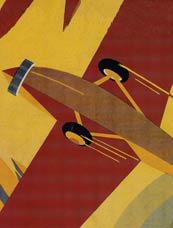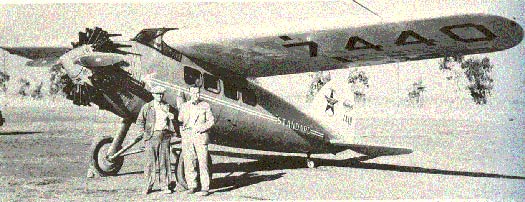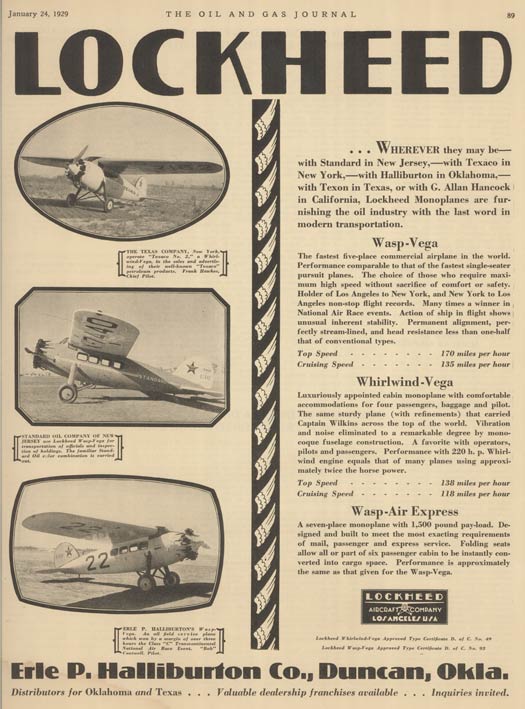|
LOCKHEED VEGA Model 5 NX/NC7440
BUZZ’S DAD
This airplane is a Lockheed Vega Model 5 (S/N 20; ATC# unidentified)
manufactured September 19, 1928 by Lockheed Aircraft Corporation,
Burbank,
CA. It left the factory with a Pratt & Whitney
Wasp CB engine (S/N 853) of 450 HP. It was a five-place
airplane weighing 4,033 pounds.
It sold sometime in 1928 to Standard Oil Development Company,
New York, NY. This airplane was the first used by Standard
Oil Company of New Jersey, and its subsidiaries, Standard
Oil Development Co. and Stanavo Specification Board. It
was used for testing Stanavo oil products, which were marketed
jointly by Standard of New Jersey, Indiana and California.
Its
original registration was NX7440, and it landed at Tucson
with this number on November 1, 1928. At some point in time,
and the NASM record does not indicate it, the airplane changed
from the NX designation to NC. Below, from contributor Tim Kalina, sits NX7440. Mr. Kalina says about the image, "This photo must have been taken when the plane was fairly new. And note that it carries the registration as X-7440. I don’t know the location but it does not look like the Lockheed factory. And the man sure looks like William Brock."
Lockheed Vega NX7440, Date & Location Unknown (Source: Kalina)
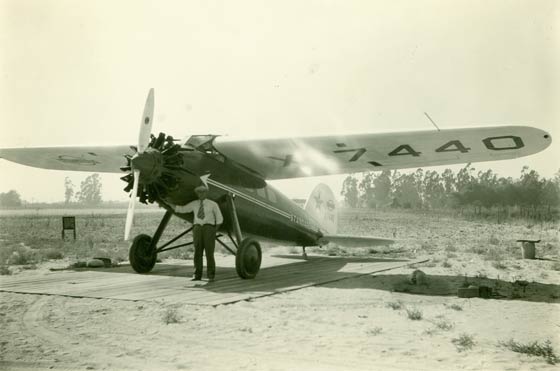 |
We find the airplane landing at Tucson twice more. The
first time on February 22, 1929 it was piloted by William
S. Brock carrying R.G. McDaniels as passenger. They
were westbound from El Paso, TX to Los
Angeles, CA. Brock did not indicate the NX or NC
designation of the airplane, simply identifying it in the
Register as "7440".
According to the NASM record, our airplane was flown during
1929 by Major E.E. Aldrin (yes, Buzz Aldrin’s father),
and in the spring of that year it was taken on a business
trip to Europe. At the time, Aldrin was corporate pilot for Standard of New Jersey. The airplane
visited France, Italy, Germany, Austria, Switzerland, Czechoslovakia,
England and Holland. Aldrin was accompanied by Mrs.
Aldrin and a mechanic. Image, below, from Allen reference
at left, page 162.
E.E. Aldrin is on the right. He signed the Register August 9, 1926
as a military officer based at McCook Field, Dayton, OH. Note there is neither NX
nor NC lettering, but "STANDARD" is painted on the rear fuselage.
Below, from Tim Kalina, are three very sharp photographs of NC7440 being loaded or unloaded for the European visit in the spring of 1929.
Lockheed Vega Model 5, Circa Spring, 1929 (Source: Kalina)
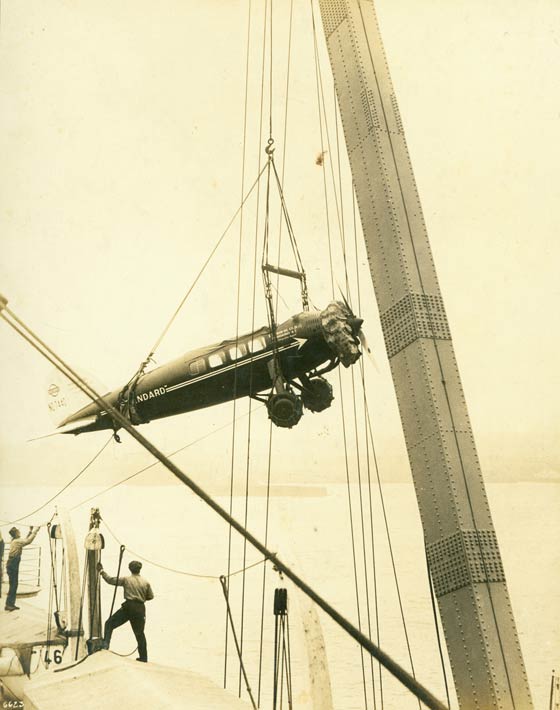 |
Note the method of slinging the airplane, with cargo net cradles under the front landing wheels and a pad around the rear fuselage. "Standard Oil Co. (N.J.)" is painted on the front fuselage, with a Broadway address. The wings are removed and not visible in any of the photographs.
Lockheed Vega Model 5, Circa Spring, 1929 (Source: Kalina)
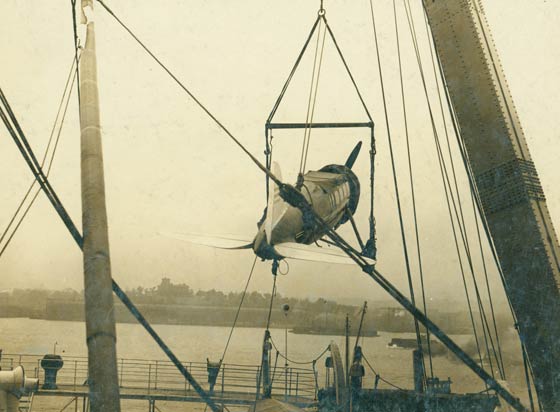 |
Mr. Kalina says about these photographs, "These are most likely promo photos from Compagnie Generale Transatlantique (which was marketed as the French Line in the USA and UK) as the backs of the photos contain hand-written comments describing the fact that the French Line could handle unusual uncrated cargo such as ships and planes. I don’t know if the Vega is being loaded or unloaded but from the looks of the watercraft I would say the location is in Europe. The liner MAY be the S.S. De Grasse as it was making Atlantic crossing at the time the Vega was shipped over to Europe for a promotional tour."
Lockheed Vega Model 5, Circa Spring, 1929 (Source: Kalina)
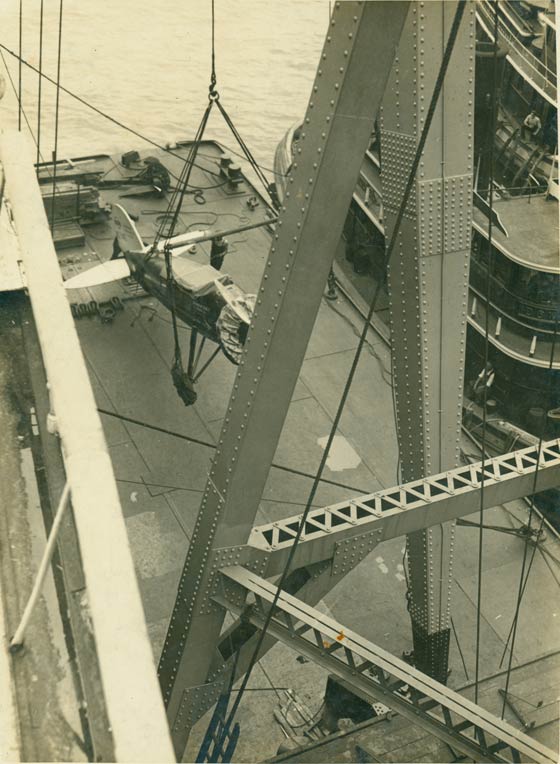 |
NC7440 (see below) was traded in on a new Vega, NC106N (not cited in the Tucson Register). Some components of 7440 went into
106N during the building-re-building at the Lockheed factory
during September- October, 1929. A new fuselage and
wing were installed, but the original Wasp engine was reused. There
was some confusion whether enough of the original airframe
was left to maintain the same serial/constructor number. Lockheed
informed the CAA that a new number, 118, was assigned.
If you want to enjoy some of the confusion around aircraft rebuilds and registration, please review this PDF download (37KB) of the two-page NASM record for NC106N , then compare it with NC869E.
The third time NC7440 landed at Tucson, on October 9, 1929,
it was flown solo by Robert E. Ellis. Ellis clearly
identified the registration number as NC7440 in the Register.
He was westbound from his home base in Newark, NJ, through
El Paso and on to Los Angeles. This
was probably the ferry flight west to the factory for the
trade-in and rebuilding cited above.
Thus, NC7440 disappeared from the record peacefully via
rebuild, unlike many of her contemporaries that disappeared
in more violent ways.
---o0o---
NC7440 was a poster airplane for the Lockheed advertisement,
below, that appeared in the Oil and Gas Journal of January
24, 1929. It is the center image. See also NC7162, the top
image.
---o0o---
THIS PAGE UPLOADED: 04/11/06 REVISED: 04/20/06, 01/16/08, 02/20/09, 12/18/09, 04/27/10
|

